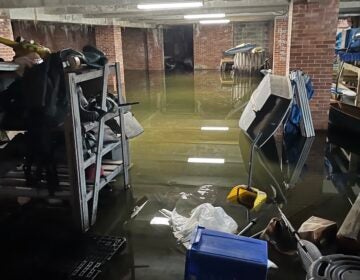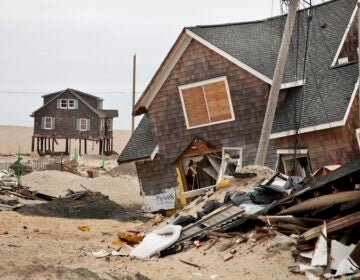Philly may lose federal dollars to protect drinking water, shifting the costs to ratepayers
FEMA is ending a grant program expected to help prevent basement flooding in Northern Liberties, South Kensington and Ludlow. Ratepayers could be on the hook for the projects.

FILE - A sign for the Federal Emergency Management Agency is pictured at FEMA headquarters, April 20, 2020, in Washington. (Al Drago/The New York Times via AP, Pool)
This story is part of the WHYY News Climate Desk, bringing you news and solutions for our changing region.
From the Poconos to the Jersey Shore to the mouth of the Delaware Bay, what do you want to know about climate change? What would you like us to cover? Get in touch.
When heavy rain sends water gushing into Philadelphia’s combined sewer overflow system, the pipes that carry both sewage and stormwater can fill up, forcing raw sewage into rivers and sometimes, basements.
The Philadelphia Water Department has a plan to fix the problem in the Northern Liberties, South Kensington and Ludlow neighborhoods. The utility plans to build 1,600 feet of new sewers, which officials say will double the capacity of the current system, reducing the risk of flooding to 1,000 basements.
The department expected the federal government to help pay for the Cohocksink Storm Flood Relief Project. Federal Emergency Management Agency had committed to contributing roughly $25 million, which would cover 70% of the project costs, according to publicly available FEMA data.
“The City worked hard to secure this grant with our state and federal partners because it will fund vital work and sustain good-paying jobs while helping to reduce the costs of infrastructure investments that residents support through their water bills,” Mayor Jim Kenney said in a 2023 press release announcing the funding. “It’s a powerful example of what we can do when all levels of government are working together.”
But last week President Donald Trump’s administration announced it is ending the Building Resilience Infrastructure and Communities, or BRIC, grant program that would have helped fund the project, cancelling applications from the last three fiscal years and returning any money not yet distributed to grant recipients back to other parts of the federal government.
“The BRIC program was yet another example of a wasteful and ineffective FEMA program,” a press release posted to FEMA’s website reads. “It was more concerned with political agendas than helping Americans affected by natural disasters.”
Without federal funds, ratepayers could be on the hook
The Philadelphia Water Department has not yet received any of the $25 million FEMA earmarked for the Cohocksink Storm Flood Relief Project, said spokesperson Brian Rademaekers. The last phase of the project is not yet in construction, and federal grant funds are distributed as reimbursements. Without FEMA funding, the project will still go forward, Rademaekers said — but ratepayers may need to shoulder the cost.
FEMA’s termination of the Building Resilience Infrastructure and Communities program — a grant program designed to help communities prepare for future disasters — is one of the Trump administration’s latest moves to slash funding for climate resilience efforts. Administration officials also hope to drastically shrink FEMA’s responsibilities, narrowing them to supporting survivors immediately after disasters, POLITICO’s E&E News reported.
Secretary of Homeland Security Kristi Noem has said she plans to “eliminate” the agency.
Ending the BRIC grant program will make it harder for communities to protect people and property from future disasters, said Lynn Budd, president of the National Emergency Management Association.
“Most communities don’t do a great job of saving money and putting it in a pot for future upgrades to infrastructure. Funds are just thin,” Budd said. “I think that you will continue to see higher impacts from disasters if there isn’t an ability to … make those communities more resilient by utilizing this type of funding.”
How BRIC funding looked to address natural disasters
The BRIC grant program, launched during Trump’s first term and expanded under former President Joe Biden, provides funding to help communities pay for planning and infrastructure projects that reduce their risk from future disasters. For example, the program can fund projects such as elevating homes to protect them from floods, building tornado saferooms in schools, burying power lines to protect them from wildfires and building floodwalls around sewage infrastructure. The grants typically cover around 75% of total project costs.
“What BRIC did was bring [funding] before a disaster, to help communities anticipate what changes to the environment might be happening in their community, what disaster damage could potentially occur, and get investments before a disaster to prevent it from ever happening in the first place,” said Tim Manning, a resilience consultant and former deputy administrator at FEMA during President Barack Obama administration. “In its absence, it leaves a large, large hole.”
Lessons from Hurricane Ida to go unfunded by Trump administration
In addition to the Cohocksink flood mitigation money, FEMA had committed $6 million to help the Philadelphia Water Department protect one of its three drinking water treatment plants from storms, according to FEMA data. The grant was expected to help the city install two emergency generators above the 500-year flood level at the Queen Lane Raw Water Pump Station along the Schuylkill River. The project is currently in the design phase, and the water department has not yet received any reimbursement payments from the BRIC grant.
In 2021, the remnants of Hurricane Ida flooded the Belmont Raw Water Pump Station, which also draws from the Schuylkill River, causing pumping to stop for 11 days and putting the distribution of treated drinking water to West Philadelphia at risk. The Queen Lane generator project is part of the city’s 25-year plan to ensure reliable drinking water into the future. Without the FEMA grant, the project will still go forward, but in the absence of other funding to replace the grant, Philadelphia Water Department customers will pay for it through their bills, Rademaekers said.
Several other BRIC grant applications from Philadelphia did not have federal funding officially obligated to them yet but had made it through a key step in the approval process and were under review. These included a $50 million grant to build a new, flood-resilient pump station at Philly’s Northeast Water Pollution Control Plant with porous paving and a green roof. According to a now removed project description posted to FEMA’s website, the current plant has overtopped more than 60 times between 2017 and 2022, endangering staff. The resilience project would prevent the plant from failing during a 100-year storm event.
Other BRIC grant applications from Philadelphia that FEMA data lists as under review include:
- $48 million for the Philadelphia Water Department’s South 42nd Street Combined Wastewater and Stormwater Pump Station Resilience Project
- $100,000 for the City of Philadelphia’s Building Code Plus Up Project
If FEMA pulls back all BRIC money, Pennsylvania could lose a total of $210 million in anticipated funding aimed at reducing future disasters, said Pennsylvania Emergency Management Agency spokesperson Ruth Miller. Funding at risk includes a $56,000 grant under review to help Tioga County — where the remnants of Tropical Storm Debby trapped people in their homes, knocked houses off their foundations and led to one death — update its hazard mitigation plan. Pennsylvania Gov. Josh Shapiro’s administration is still working to determine the full impact of FEMA’s announcement on the state, Miller said.
The FEMA Press Office did not address WHYY News’ questions about the fate of funds already obligated for specific projects, like the Queen Lane generator project or the Cohocksink Storm Flood Relief Project. Instead, a spokesperson pointed WHYY News to the press release FEMA issued last Friday, which does not specify whether grant recipients will be able to access funds that have been obligated but not paid out.
Based on FEMA’s statement, Manning expects grant applicants will not receive any money they have not already drawn down from the federal government as reimbursements.
“These projects have been identified as critical to the community and passed a series of extremely challenging vetting and review by FEMA,” Manning said. “What [FEMA’s statement] indicates to me is … that money will be de-obligated and swept back.”
Some see a ‘short-sighted’ cut to life-saving investments
Manning worries that without BRIC grants, some disaster resilience projects will go undone.
“That’s going to mean increased vulnerability for communities, higher disaster costs when a storm does happen and more challenges and risk to public safety,” he said. “It’s a really short-sighted decision.”
Analyses have shown that investments in proactive disaster mitigation are cost-effective, saving $6 to $13 in costs later on.
“The problem is that you have to pay that $1 in the first place,” said Anna Weber, a policy analyst who studies climate adaptation at the Natural Resources Defense Council. “That can be hard to budget for, especially if you’re a cash-strapped community or state government.”
Weber said it’s disappointing to see the federal government pulling back from investments in preparing for hazards like floods, hurricanes and wildfires, as human-caused climate change helps fuel more costly disasters.
“These are projects that save lives, they save taxpayer dollars, and they make communities safer,” she said.

Subscribe to PlanPhilly
WHYY is your source for fact-based, in-depth journalism and information. As a nonprofit organization, we rely on financial support from readers like you. Please give today.








